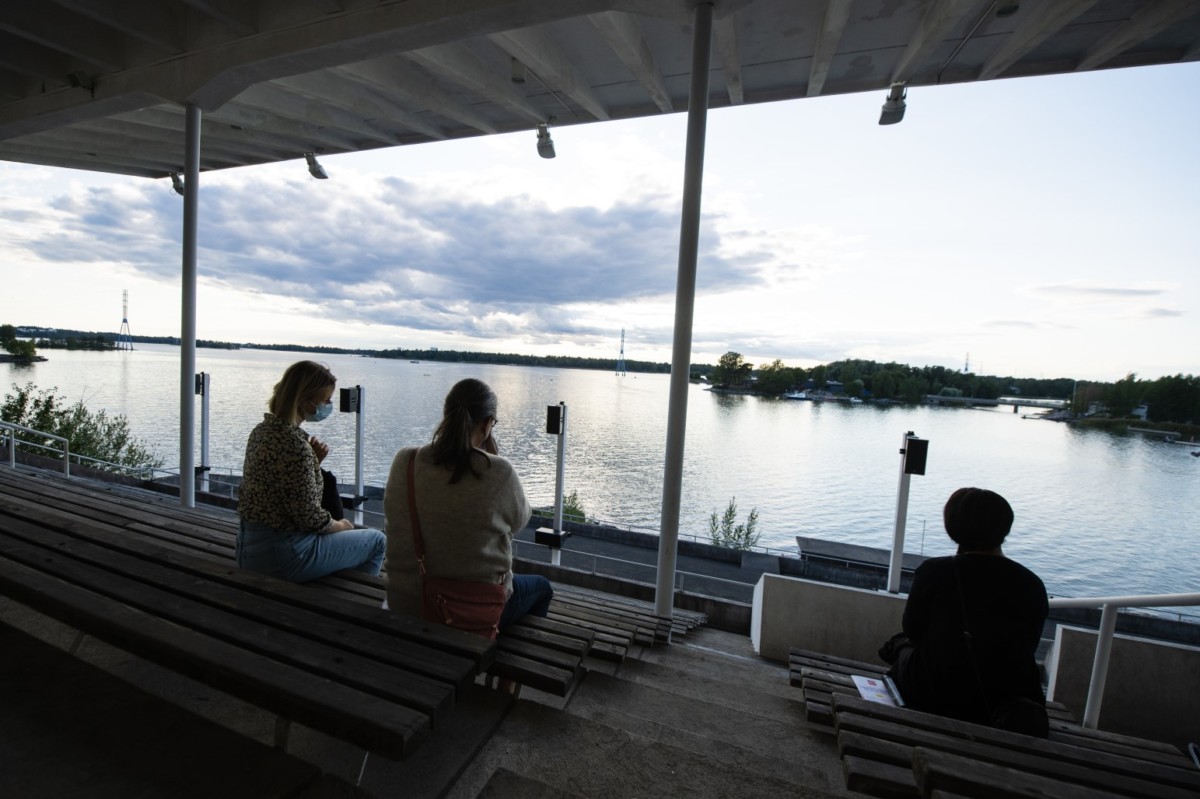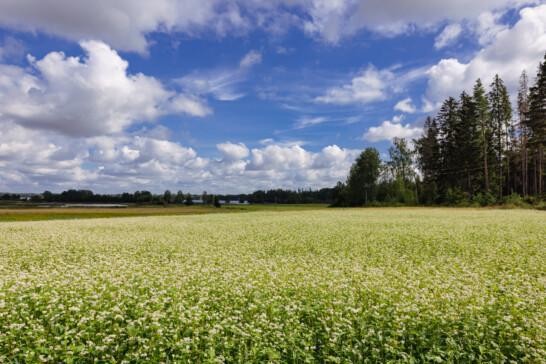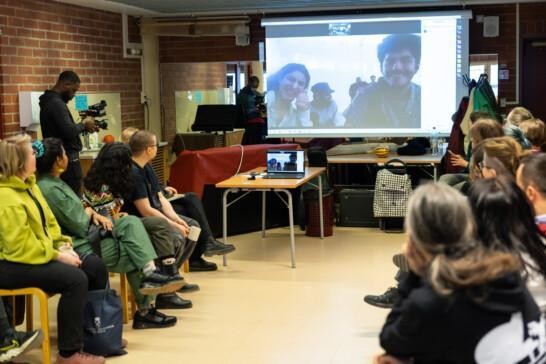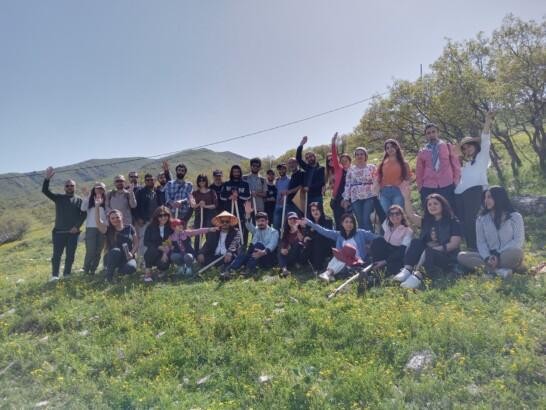Curator’s texts Essay
Curator´s Essay: Listening Through the Dead Zones

Bathed in Sound Like Water
IHME Helsinki 2020: Jana Winderen, Listening Through the Dead Zones, 6–25.8.2021, Helsinki
August 2021, Töölö Rowing Stadium, Helsinki. I sit on the stadium bench in the grandstand facing the sea and greet people climbing up the steps. I recognize a couple who have been to the stadium to listen to Jana Winderen’s sound work several times, sometimes walking between the benches and speakers looking for the best place to listen, sometimes resting on the benches wrapped in a blanket, sometimes alone, and then together again. Many visitors spend an hour at the stadium, or even more. Many come again. When you climb the stairs, the wind blows against you and the open seascape takes your breath away for a moment. The warmth of the evening sun and its orange-yellow light flood the grandstand, landing on the faces of all those present and on a swarm of insects resting on the white wall. Jana Winderen’s site-specific sound work fine-tunes the senses of the audience to the flow of recorded and real-time sounds.
Listening Through the Dead Zones. That is the title of Jana Winderen’s IHME Helsinki Commission 2020. Dead, almost oxygen-free areas have spread in all the seas on our planet. Anthropogenic activity is depleting the soil both on land and at the bottom of the seas, including the Baltic, which has this artwork on its shores. Dead areas are defined differently in different sea areas. In the Baltic dead areas have only 2mg of oxygen per litre, and only viruses and bacteria can survive in them. Winderen’s sound work gives us a chance to listen to the sounds of aquatic animals whose habitats are still viable. The sounds she has recorded come from water animals, such as tiger perch, pilot whale, humpback whale, and crustacea. Beneath the surface of the sea there is one of the richest sound worlds on our planet, says Tony Myatt, a long-time collaborator of Winderen’s on the spatial sound design of large installations such as this one. Slipping into the quieter patches left between Winderen’s recordings we hear the sounds of the environment, every moment different. They are generated by the forces of nature, human beings and birds, and the sounds are changing according to the weather, the rhythm of the city and the time of day.
Jana Winderen has been concerned about the state of the environment ever since she was a child. She was born in Bodø on the shores of the Atlantic and spent her school years on a farm beside Norway’s largest lake, Mjøsa. In the 1970s, the lake was in danger of complete eutrophication, i.e. the death of all the fish in it. The situation was, however, rectified when a water-treatment plant was built in the area, and the lake is currently doing better. Nevertheless, Winderen’s concern for the loss of aquatic-ecosystem diversity has not gone away, but expanded to include all the water systems and seas on our planet. And that concern is not unfounded – the hydrosphere is one of the planet’s life-sustaining systems.
Winderen’s artistic work is intended to raise awareness of underwater biodiversity. She brings her audience the sounds of marine animals that she has recorded underwater, challenging the notion that the underwater world is a quiet one. In her work, Winderen strives to ensure that, in future, general education will involve knowing what fish or crustacea sound like, and that noise and light pollution from humans interfere with communication between marine animals, and thus with their reproduction. Besides the sound installation, Winderen’s commission includes numerous expert interviews and seminar presentations on the marine environment. Knowing about the eutrophication and warming of the Baltic Sea and what each of us can do to mitigate them adds to the public’s ability to understand our dependence on nature and natural resources, and thus gives people an opportunity to participate in the great sustainability transformation.
Over the last twenty years, Winderen has spent a lot of time on and below the water surface, on research vessels, fishing boats and shores, swimming and listening to aquatic animal communication, recording. She loves being on the water, listening with it. The feminist philosopher Astrida Neimanis, who coined the term hydrofeminism, considers her time by water to be the main inspiration for her research: slowing down, observing and thinking with water and with the life entwined around it. Hydrofeminism views the human being as part of the water cycle on our planet: we humans are bodies in which water flows slowly – in and out, in and out – as important as breathing. It keeps us alive, as part of the flow of life. The hydrofeminist body is in many ways intertwined with the world around it: with other living beings, situations, place, matter and time. Time spent with Winderen’s sound work tuned to the open seascape slows the visitor’s heart rate and deepens their breathing into a state of rest. A similar effect occurs when we immerse our bodies in warm water, we relax, our minds are freed from hurry.
Many visitors thought the work was at its best in the rain. That is when the circulation of water becomes visible. Rain creates a visual and auditive, rhythmic layer in the experience of the artwork. It connects sky, sea and land. Rainwater runs down along gutters and fills potholes to form puddles, from where it is absorbed back into the ground. The shifting pitter-patter of the rain also makes the water present in the sound of the environment, underscoring the importance of the element of water to the species appearing in the work. Winderen’s work is a portal into our planet’s underwater sound worlds, but it also sharpens our understanding that through the constant movement and circulation of water, the water systems, and we ourselves, are in continuous contact with each other through our bodies. Winderen’s work suggests a new, collective way of being, a breathing-like bodily connection, flowing together, a sense of belonging to the place, to the water, the water systems and other living beings.
Visitors said the work was calming, even healing. This experience, too, links it with hydrofeminism, since the imperative of hydrofeminism is caring for and supporting the bodies of others, regardless of their species. Angela Davis writes that feminism is about much more than social gender, hydrofeminism reminds us that it is about much more than people, says Astrida Neimanis. The melancholy moaning, rising up the scale, of one of the main characters in Listening Through the Dead Zones, the pilot whale, evokes an emotional response from us. The world opened up by this sound work reveals overwhelmingly many underwater bodies invisible to us humans, a communication and life unheard by our ears. Along with this experience, our sense of responsibility for their wellbeing and their future begins to grow.
Paula Toppila
Curator and Director of IHME Helsinki
Thank you to Jana Winderen for IHME Helsinki Commission 2020 and good collaboration, our audiences for coming and giving loads of positive feedback and Astrida Neimanis for inspiring writing and talks.


